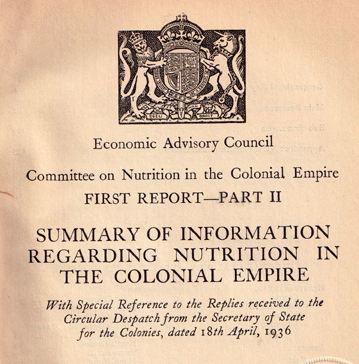
Say what you will about colonial empires, but at least they generate reports. I recently came across a British report to Parliament in 1939 entitled “Summary of Information Regarding Nutrition in the Colonial Empire.†Four pages are devoted to Aden Colony, which is said to have an area of 75 square miles, a population in 1931 of 45,992, a birthrate in 1937 of 32.07 per 1,000, an infant mortality rate in 1937 of 196.61 per 1,000, and a death rate in 1937 of 31.72 per 1,000. For part 1, click here. I attach more excerpts below:
3. Diet and Health (deficiency diseases and other relevant considerations). – On the whole, Aden can boast a high standard of public health. The greatest drawback is overcrowding. Large families occupy inadequate and ill-ventilated accommodations in which, as often as not, the domestic goat also claims a quota of space. In consequence of these conditions, respiratory and alimentary diseases are all too common. Diseases directly attributable to qualitative dietary deficiency are not a prominent feature of hospital returns in Aden and the more classical of the tropical diseases – beriberi, scurvy and pellagra – do not occur. Evidence of qualitative deficiency is found, however, in the incidence of rickets among children and of certain eye infections. An examination of 527 unselected children (consecutive cases treated in the Civil Hospital) showed that 33, 0r 6.2 per cent, were suffering from rickets. Although most of these cases were mild and without gross deformity, their occurrence indicates that all is not well with the diet, mode of living or both. The most common eye conditions met with are the various forms of conjunctivitis and keratitis. These yield rapidly to administration of vitamin A as cod liver oil. Xerophthalmia and keratomalacia are uncommon; but night-blindness is frequently found among adults. Other facts worthy of record are the healthy incidence of intestinal and bronchial affections. Urinary calculus, too, is the cause of much invaliding and points to deficiency of vitamin A and of animal protein.
Data in regard to physical standards in relation to nutritional status are almost entirely lacking. The Arab is of slight but stocky build averaging 5 ft. 9 ins. in height and turning the scale at 105-115 lb. with, as a rule, a well developed musculature. The Jew is slimmer and taller, and light in proportion to his height; in physique he is inferior.
4. Economics of Diet (relation to local agriculture, cost, tariffs, etc.). – The peculiar local topography precludes the Colony from producing its own natural foodstuffs. The fishing industry and the local production of milk and eggs are exceptions to this general rule; and it is true that there are possibilities of a limited agriculture on the oasis of Sheikh Othman and at Hiswa. But the main source of supply must remain, as it has always been, imports from Arabia and overseas. Aden is a free port and therefore prices of essential foodstuffs are not raised by customs charges. An efficient marketing system with minimal dues makes fresh meat and vegetables readily available.
The relationship between purchasing power and food consumption is noticeable. As a rule labour supply is in excess of demand and wages are low. Moreover, the demand for food depends entirely on earnings, for labour is irregular. Consequently as the labourer has no other resources, the individual daily diet is too frequently below actual requirements…